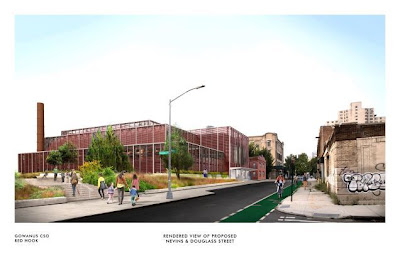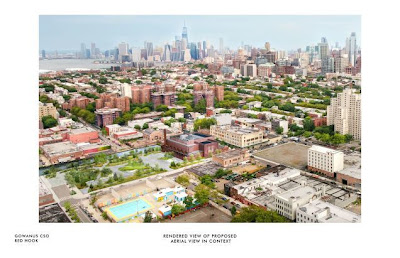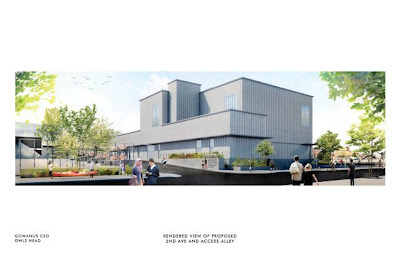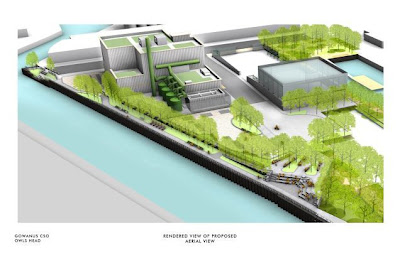When Completed, Underground Storage Tanks Will Dramatically Reduce Pollution into the Gowanus Canal
3.6 Acres of Public Waterfront Space to Include Waterfront Esplanades; Spaces for Community Gathering, Performances, and Environmental Education; a Kayak Launch; and Ecosystem Restoration
New York City Mayor Eric Adams, New York City Chief Climate Officer and New York City Department of Environmental Protection (DEP) Commissioner Rohit T. Aggarwala, and U.S. Environmental Protection Agency (EPA) Region 2 Administrator Lisa F. Garcia today broke ground on the first of two underground storage tanks that will have the combined capacity to prevent up to 12 million gallons of sewer overflow during rainstorms, stopping it from polluting the Gowanus Canal. This groundbreaking marks an important alignment among city leadership and the EPA to get these projects on track after Gowanus was categorized as a Superfund site in 2010. These two major infrastructure projects will make an estimated $1.6 billion investment in Brooklyn’s waterways and public spaces, significantly improve the health of the canal, and create 3.6 acres of new public waterfront open space and amenities for the Gowanus community.
“Today’s groundbreaking will protect the Gowanus Canal from pollution and deliver acres of new public spaces and waterfront access to New Yorkers,” said Mayor Adams. “This project is a powerful statement about our city’s adaptability and determination, and we’re not stopping here in Gowanus. We want to make sure that every waterway in New York City is clean enough for the dolphins we saw in the Bronx River to swim in, and whenever we have opportunities to bring new public open spaces to communities that are crying out for them, we’re going to seize those chances.”
“People in Gowanus have been waiting for this day for a long time, and, today, we’re proud to say that the wait is over,” said Deputy Mayor for Operations Meera Joshi. “We’re breaking ground on 3.6 acres of new public space and two tanks that will protect the Gowanus Canal, ultimately delivering a cleaner community with a better quality of life for residents. And we’re grateful to have true partners in this effort at all levels — from the EPA, to local, state, and federal elected officials to community advocates, all dedicated to making Gowanus a better place to live.”
“We are thrilled to be aligned with the EPA on a vision for a cleaner Gowanus Canal, and we are committed to doing our share of the work on an accelerated schedule,” said Chief Climate Officer and DEP Commissioner Aggarwala. “We are grateful to EPA Region 2 Administrator Garcia for her leadership in moving this major infrastructure project forward and to the local stakeholders for their environmental advocacy and valued input into the design of the public spaces. I’d also like to thank the dedicated team at DEP’s Bureau of Engineering, Design, and Construction, for the expertise and creativity that made this accelerated timetable possible.”
“In our dense urban environment, thinking outside the box is key to bringing new green spaces to New Yorkers, and this critical combined sewer overflow infrastructure project is yet another wonderful example of interagency collaboration, creativity, and partnership towards that goal,” said New York City Department of Parks and Recreation Commissioner Sue Donoghue. “The 3.6 acres of brand-new open space at these two sites will collectively provide new recreational amenities and waterfront access where none previously existed, and we congratulate DEP and the EPA for the progress made on improving water quality in Gowanus.”
“The PDC is thrilled to support the construction of the Gowanus combined sewer overflow facility, which will help keep the Gowanus Canal clean,” said New York City Public Design Commission (PDC) Executive Director Sreoshy Banerjea. “The exemplary design, which was recognized with a PDC design award in 2019, employs a terracotta façade to blend in with the surrounding brick buildings, while also establishing a contemporary presence in the community. Gracious areas for multipurpose and passive recreation are provided and will be an incredible asset to the community. The Gowanus facility illustrates how critical infrastructure can be integrated thoughtfully with community space in service of New Yorkers and their public realm.”
“Today marks the achievement of an important milestone in our shared efforts to restore and protect the health of the Gowanus Canal,” said EPA Regional Administrator Garcia. “Under the leadership of Mayor Adams and New York City DEP Commissioner Aggarwala, the city has taken an important step forward in implementing the EPA-ordered Superfund cleanup and safeguarding the health of our environment and the well-being of this community.”
The Gowanus Canal was originally a tidal creek winding through marshland, but, in the 1860s, it was converted into a 100-foot-wide, 1.8-mile-long canal for industrial use. Chemical plants, oil refineries, and other heavy industries operated next to the canal and discharged their waste into it. Sewer overflows only added to this pollution. The EPA declared the location a Superfund site in 2010 and kicked off efforts to clean the canal and remediate the area.
By intercepting the overflow from the sewer system during rainstorms, the underground tanks — announced as part of today’s groundbreaking — will help keep the remediated canal clean. In addition to the sewage overflow tanks at the center of today’s announcement, as a part of the Superfund designation, EPA is in the process of dredging approximately 581,000 cubic yards of polluted sediment from the bottom of the canal and capping the bottom to prevent further contamination.
Breaking Ground on First Tank
Today’s announcement celebrates the groundbreaking of what will be the first tank, located at the north end of the canal, bounded by Nevins Street, Butler Street, and Degraw Street. Over the last year, the city has cleared the project site, including carefully deconstructing and salvaging the brick, terracotta, and bluestone elements of the 1913 Gowanus Station building, which will be reconstructed as a part of the project. Today, the city is kicking off the $329 million contract for the excavation and construction of the tank that will hold up to 8 million gallons of combined sewage during rainstorms, as well as the waterfront public open space that will sit on top of the tank.
In addition to the tank, the project will include a headhouse building to host the mechanical and electrical systems for the tank, odor control equipment, and screens that will remove debris from the sewer overflow.

Rendering of headhouse for the first tank.
Atop the tank, which extends underground nearly two blocks from Butler Street to Degraw Street, the city will construct a 1.6-acre waterfront public open space. The landscape will feature a waterfront esplanade with reclaimed concrete block benches, large planted areas that frame views to the canal, gently sloped lawns bordered with seatwalls and benches, granite pavers, and weathered steel accents. Areas of plantings will manage stormwater runoff and reduce the heat island effect.

Rendering of public space design atop first tank site.
Plans for the Second Tank
The city is on schedule to begin site preparation work for the second tank, which will hold up to 4 million gallons and will be located at the bend of the canal on a triangular peninsula at Second Avenue and Sixth Street, before the EPA’s June 2023 milestone. Similar to the other site, this project will include a headhouse to support the tank and two acres of waterfront public open space. The city has already begun bulkhead replacement work on site, and, over the last year, staff have conducted a robust community engagement process to inform the design of the city’s facilities and public open space. Like the other site, the design is resilient and sustainable, with all critical equipment elevated above the floodplain, concrete with recycled content, high-efficiency equipment, and green roofs.

Rendering of headhouse for second tank.
The two-acre public open space wraps the full 1,770 linear feet of waterfront of the site. The design balances the operational needs of the city’s infrastructure with meaningful open space for the public to engage with the waterfront and the native ecology, as well as to foster environmental education, stewardship, and community engagement. Based on directions from the community in a series of workshops, the design includes a 3,000-square-foot tidal wetland on the southwestern tip of the peninsula, water access at the Second Avenue street end, and New York City’s first-ever public ADA-accessible kayak launch at the Sixth Street turning basin. The plan provides community gathering space in flexible plazas atop the tank, as well as amphitheater seating, lawn space, and a shaded outdoor classroom. The plan also includes kayak storage. The landscape design reinterprets Gowanus’ urban wildness — restoring native plants suited for a coastal condition that can support marine habitat — in addition to absorbing stormwater runoff or withstanding tidal inundation.

Rendering of public space atop second tank site.
The site will remain home to the New York City Department of Sanitation’s salt and plow storage and composting operations, as well as the Gowanus Canal Conservancy, and this project will provide new facilities to support those operations.
New York City’s Sewer System and Efforts in Reducing Overflows
Like many older cities, New York City’s sewer system is primarily combined, meaning the sewer under the roadway carries wastewater (from flushed toilets, sinks, and showers) from homes and businesses, as well as rain and snow that drains to the catch basins located on street corners.
During dry weather periods, all the wastewater in New York City — about 1.3 billion gallons per day — travels through the sewer system for treatment at one of the city’s 14 wastewater resource recovery facilities. During wet weather periods, the system can handle more than double the volume of wastewater than on a dry day. When the system does reach capacity, it discharges through outfalls into local waterways, rather than back up into homes and businesses. This is especially problematic in smaller waterways like the Gowanus Canal.
Over the last several decades, DEP has invested substantial resources to reduce the volume and frequency of combined sewer overflows. As a result, the New York Harbor is cleaner and healthier today than it has been in more than 100 years, and sightings of dolphins, seals, and even whales are becoming more common as the cleaner water attracts their food sources.
Overflow retention tanks — such as those being built along the Gowanus Canal — are one strategy that DEP uses to reduce sewer overflows. Rather than discharging into the canal, the overflow is routed to the retention tanks where it will be held until the storm passes. Then, the wastewater will be pumped back into the sewer system and conveyed to a wastewater resource recovery facility for treatment.
Another strategy to reduce sewer overflows involves the use of green infrastructure, which intercepts stormwater before it can enter the sewer system and contribute to overflows. New York City has the largest and most aggressive green infrastructure program in the country, with more than 11,000 installations built to date and thousands more currently in the planning and design phase. The most common type of green infrastructure in New York City is the curbside rain garden.
DEP has made substantial investments in the Gowanus neighborhood, including in recent years:
- $177 million to rehabilitate the Gowanus Canal Flushing Tunnel — which brings water from the Buttermilk Channel to the head of the canal — and to upgrade the Gowanus Wastewater Pumping Station and construct a new force main that reduced sewer overflows into the canal;
- Installation of high-level storm sewers along Third Avenue at a cost of $53 million to intercept stormwater from entering the combined sewer system;
- $27 million to upgrade the drainage system along Ninth Street;
- Construction of more than 70 green infrastructure installations throughout the neighborhood, including rain gardens and two green playgrounds; and
- Construction of green infrastructure installations at the New York City Housing Authority’s Gowanus Houses that capture nearly 2 million gallons of stormwater in a typical year.
No comments:
Post a Comment